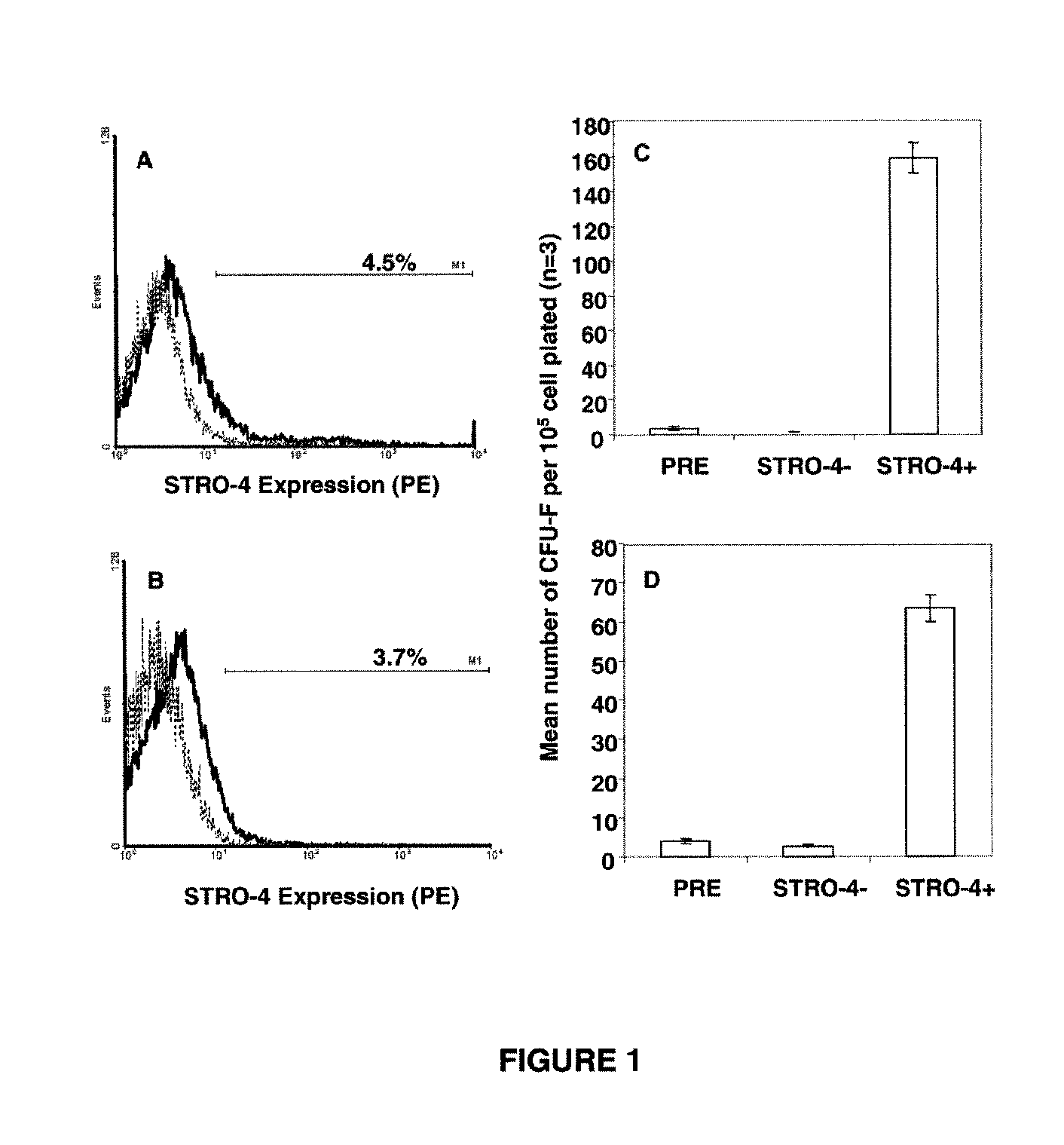Monoclonal antibody stro-4
a monoclonal antibody and antibody technology, applied in the field of heat shock protein 90beta, can solve the problems of limited progress in examining the therapeutic potential of multipotential cells in ovine models of human disease, and achieve the effect of improving the clinical efficacy and safety of treatmen
- Summary
- Abstract
- Description
- Claims
- Application Information
AI Technical Summary
Benefits of technology
Problems solved by technology
Method used
Image
Examples
example 1
Materials and Methods
Immunisation of Mice and Production of Antibody Secreting Hybridoma Cell Lines
[0185]VCAM-1 / CD106 positive immunoselected ovine MPC were harvested and resuspended in 300 μl PBS supplemented with 20 μg muramyl dipeptide (Sigma Chemical Company, St. Louis, Mo.) as adjuvant. BALB / c mice were immunised intraperitoneally with 5×106 BMSSC, and subsequently boosted a further 3 times at three-week intervals to ensure adequate affinity maturation of the immune response. Three days prior to fusion, 5×106 cells resuspended in 100 μl PBS were administered via the tail vein. Immediately prior to fusion, mice were sacrificed and their spleens aseptically removed. Hybridomas secreting antibodies reactive with cultured BMSSC were made by fusing the NS1-Ag4-1 murine myeloma cell line and spleen cells derived from BALB / c mice immunised with trypsinised cultured ovine MPC. Fusion of splenocytes and myeloma cells was performed essentially as previously described (Filshie R J et al.,...
example 2
Generation of the Monoclonal Antibody STRO-4 that Identifies Ovine and Human MPC
[0195]A panel of mouse monoclonal antibodies (mAb) reactive with ovine MPC were generated following the fusion of splenocytes derived from mice immunized with cultured VCAM-1 / CD106 positive derived ovine MPC with the myeloma cell line, NS1-Ag4-1, as described in the methods. Preliminary screens were designed to identify mAbs which reacted with both ovine and human clonogenic MPC(CFU-F). One such hybridoma, STRO-4, was selected for further analysis as it identified a minor subset of ovine and human bone marrow mononuclear cells (FIGS. 1A and B) and efficiently isolated ovine and human CFU-F (FIGS. 1C and D). Ex vivo expanded ovine and human MPC maintained high cell surface expression of the antigen identified by STRO-4 (FIGS. 2A and B) and exhibited the capacity for multi-lineage differentiation into osteoblasts, adipocytes and chondrocytes (FIG. 3). The immunoglobulin isotype of STRO-4 from tertiary hybr...
example 3
Characterisation of the Antigen Recognised by STRO-4
[0196]Immunoprecipitation was used to purify the STRO-4 antigen from the immature human osteosarcoma cell line, MG63, which expressed high cell surface levels of the STRO-4 antigen (FIG. 2C). Human MG63 plasma membrane proteins were extracted with 1% NP40 as described in the methods, and incubated with the STRO-4 antibody. The STRO-4 immunoprecipitated protein was recovered using sheep anti-mouse IgG antibodies conjugated to magnetic Dynal beads and resolved by SDS-polyacrylamide gel electrophoresis (SDS-PAGE) as described in the methods. Coomassie Blue staining of resolved immunoprecipitates revealed a specific peptide band with an apparent molecular mass of 90 kDa (FIG. 4). The 90 kDa protein fragment was excised from the gel and prepared for mass spectrometry and amino acid sequence analysis. The resultant STRO-4 peptide sequences were used to survey the Protein database at the National Center for Biotechnology Information and f...
PUM
 Login to View More
Login to View More Abstract
Description
Claims
Application Information
 Login to View More
Login to View More - R&D
- Intellectual Property
- Life Sciences
- Materials
- Tech Scout
- Unparalleled Data Quality
- Higher Quality Content
- 60% Fewer Hallucinations
Browse by: Latest US Patents, China's latest patents, Technical Efficacy Thesaurus, Application Domain, Technology Topic, Popular Technical Reports.
© 2025 PatSnap. All rights reserved.Legal|Privacy policy|Modern Slavery Act Transparency Statement|Sitemap|About US| Contact US: help@patsnap.com



